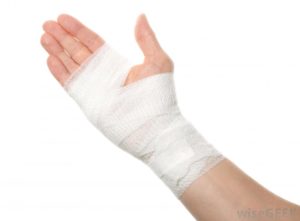 As a Home Health Care Provider in Metro Milwaukee, we treat a lot of patients with wounds. Some difficult to heal wounds including diabetic ulcers and abdominal wounds can be treated with a Wound Vac. This technique is called Negative-Pressure Wound Therapy (NPWT.) The basic idea is that the wound is covered with an air sealed bandage. The bandage has two connections. One connection allows any drainage from the wound to escape the sealed bandage through a tube. The other connection has a hose that is connected to a wound vacuum. The wound vacuum applies either a constant or intermittent vacuum to the bandage. This vacuum creates a negative pressure environment around the wound. This vacuum draws fluid from the wound area and increases blood flow to the wound. The wound vacuum can also supply the wound fluids to irrigate the wound area. All of this creates a closed moist healing environment that reduces edema.
As a Home Health Care Provider in Metro Milwaukee, we treat a lot of patients with wounds. Some difficult to heal wounds including diabetic ulcers and abdominal wounds can be treated with a Wound Vac. This technique is called Negative-Pressure Wound Therapy (NPWT.) The basic idea is that the wound is covered with an air sealed bandage. The bandage has two connections. One connection allows any drainage from the wound to escape the sealed bandage through a tube. The other connection has a hose that is connected to a wound vacuum. The wound vacuum applies either a constant or intermittent vacuum to the bandage. This vacuum creates a negative pressure environment around the wound. This vacuum draws fluid from the wound area and increases blood flow to the wound. The wound vacuum can also supply the wound fluids to irrigate the wound area. All of this creates a closed moist healing environment that reduces edema.
When using a wound vac in home health care, there are three basic dressings that we use. All dressings consist of 2 to 3 layers. The outside layer is the same, a film drape that adheres around the wound and creates the air tight seal. For the second layer, typically an open cell foam, gauze and a transparent non-adhering film, or a honeycombed textile with a dimpled wound contact surface are used.
In home health care, the wound vac bandage with open cell foam is the most common. All wound care done by a nurse in home health care is always prescribed a by a Physician. So, the process for dressing a wound in the patient’s home using a wound vac bandage with open cell foam is as follows
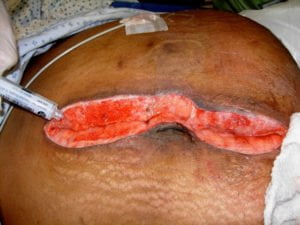 The wound bed is cleaned with normal saline or a wound cleanser to remove debris.
The wound bed is cleaned with normal saline or a wound cleanser to remove debris.
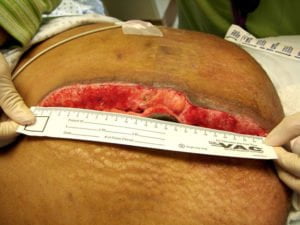 The wound bed is examined. It should have pink/red granulation tissue. Any drainage, tunneling, or cavities are noted. The wound size is assessed using a wound measuring tape.
The wound bed is examined. It should have pink/red granulation tissue. Any drainage, tunneling, or cavities are noted. The wound size is assessed using a wound measuring tape.
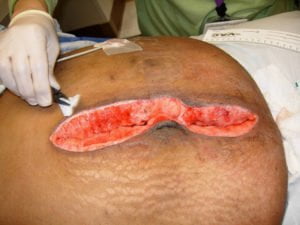 The condition of periwound skin is checked. The wound edges are cleaned and dried. Wound margins around the wound are prepped with a skin protectant.
The condition of periwound skin is checked. The wound edges are cleaned and dried. Wound margins around the wound are prepped with a skin protectant.
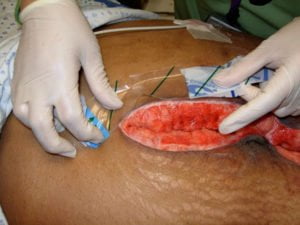 Window paning the wound edges with film drape is not required, but has the advantage of protecting the periwound surface if the foam material extends beyond the wound edges. It can also help create a better seal around the wound.
Window paning the wound edges with film drape is not required, but has the advantage of protecting the periwound surface if the foam material extends beyond the wound edges. It can also help create a better seal around the wound.
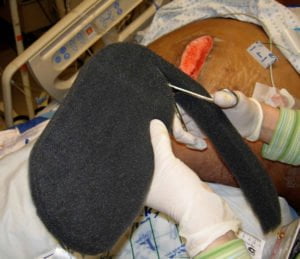 The open cell foam is cut to fit the size and shape of the wound. The foam should never be cut over the top of the wound to make sure bits of foam do not fall into the wound. This is a clean procedure, not an aseptic one.
The open cell foam is cut to fit the size and shape of the wound. The foam should never be cut over the top of the wound to make sure bits of foam do not fall into the wound. This is a clean procedure, not an aseptic one.
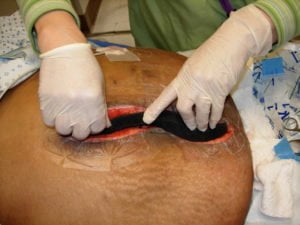 The shaped foam is cut into the wound. The wound is filed with enough foam so that when the vacuum is applied, the height of the foam is close to the top of the wound margins. The number of foam pieces placed into the wound is noted by the nurse. This is critical if foam is inserted into cavities.
The shaped foam is cut into the wound. The wound is filed with enough foam so that when the vacuum is applied, the height of the foam is close to the top of the wound margins. The number of foam pieces placed into the wound is noted by the nurse. This is critical if foam is inserted into cavities.
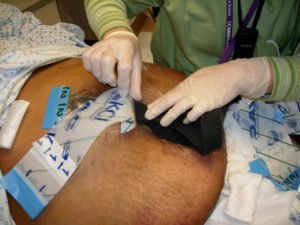 The transparent film drape material is cut and applied to cover the foam and wound. The drape material should extend out onto the periwound about a half an inch all around.
The transparent film drape material is cut and applied to cover the foam and wound. The drape material should extend out onto the periwound about a half an inch all around.
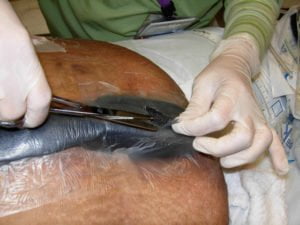 A 2 cm (quarter) sized hole is cut in the film drape above the foam.
A 2 cm (quarter) sized hole is cut in the film drape above the foam.
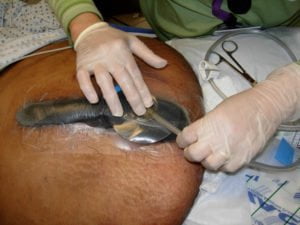 The tubing pad is applied over the hole in the film drape with the tubing arranged in a direction and position that is comfortable for the patient and avoids excessive pressure against the skin.
The tubing pad is applied over the hole in the film drape with the tubing arranged in a direction and position that is comfortable for the patient and avoids excessive pressure against the skin.
The tubing from the dressing is connected to the tubing coming from the Wound Vac suction canister.
The Wound Vac suction is activated and checked for any air leaks. The wound therapy levels are set to what the Physician has prescribed in the wound treatment for the patient.
When suction is applied, the foam will contract to a raisin-like appearance. The dressing is labeled with the date, time, initial, and number the foam pieces placed into the wound. Everything is documented in the home health nursing note.
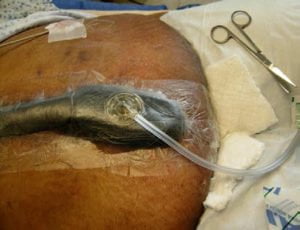
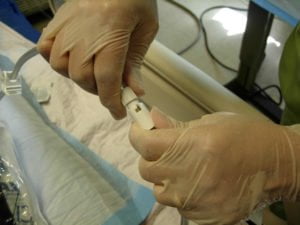
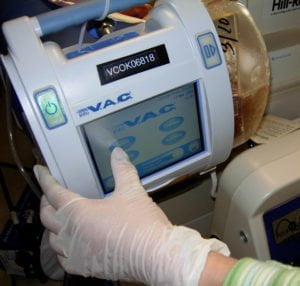
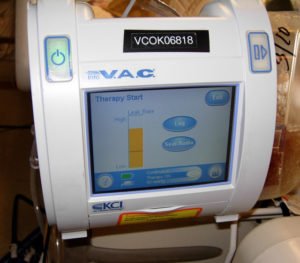
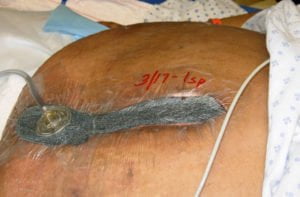
How much is wound vac machine ?